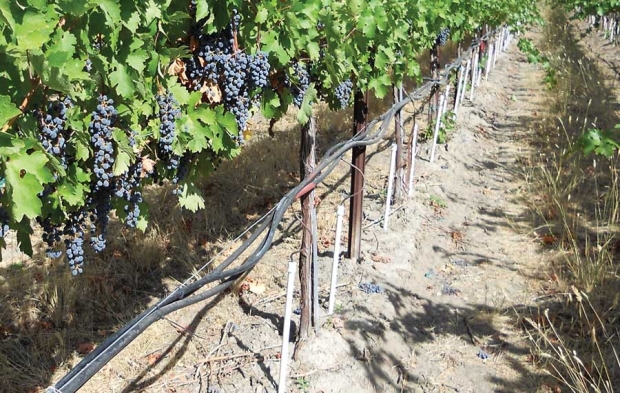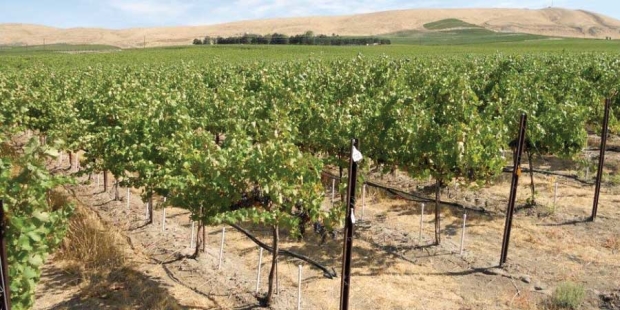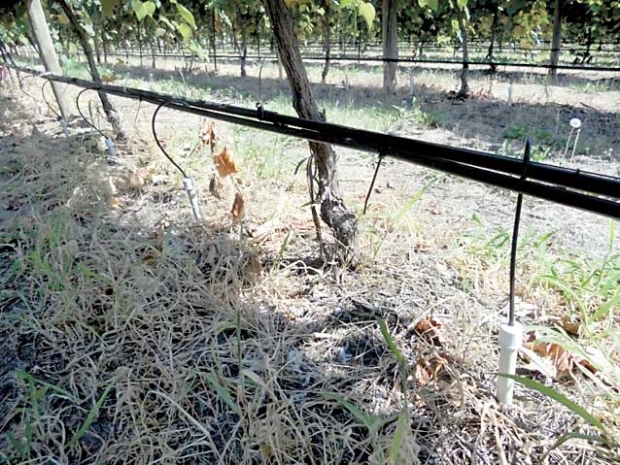
Washington State University researchers are conducting an irrigation study on a Cabernet Sauvignon block on Washington’s Red Mountain, near Prosser. (Courtesy Pete Jacoby)
Wine grape growers can improve water use efficiency and still produce comparable yields by applying less water deep beneath the soil surface rather than through surface drip irrigation, a Washington State University study showed in its first year.
No one is advocating that growers make the switch just yet.
The vineyard research will continue for several years to understand the concept in both the Cabernet Sauvignon block from year one and an additional Chardonnay block.
Still to be studied is whether low-volume, root-zone deficit irrigation affects grape or wine quality. However, the initial results were encouraging to the participants.
“We’re trying to find the sweet spot, both in depth and amount and style of irrigation, but this was a really good year,” Dr. Pete Jacoby, WSU professor and plant ecologist, told Good Fruit Grower. “By the time we get to the end of the third or fourth growing season, when the vineyard has experienced different growing conditions, we should have a good indication of the appropriate application and have some recommendations for growers.”
Jacoby conducted the first year of the study on a 6-year-old block of Cabernet Sauvignon grapes at Kiona Vineyards on Washington’s Red Mountain.
Scott Williams of Kiona said he was encouraged by the early results. As currently implemented, the idea probably isn’t practical on a commercial scale, but that isn’t the point yet, he said. The information gleaned from the research will be beneficial.
“As a grower, if you’re going along and all of a sudden your water supplies are reduced by 30, 40 percent, which has happened a couple of times the last decade, knowing how you can manage that water is a significant piece of knowledge,” he said.
Cabernet on deep deficit

A nice benefit of deficit irrigation: fewer weeds. (Courtesy Pete Jacoby)
Growers have tried before to water their vineyards from underground, only to walk away discouraged by buried lines that get clogged by soil or chewed by gophers, leaving damage that is imperceptible until it’s too late to save the plants, Jacoby said.
Yet most plants irrigated by drip irrigation tend to have 80 to 90 percent of their root mass in the top 1.5 feet of soil, he said, making them more susceptible to cold damage and less efficient.
The Cabernet block, planted on 6-foot (in row) by 8-foot (between rows) spacing in fine, loamy sand, previously had been drip irrigated. Jacoby and his research team installed vertical delivery tubes 18 inches on either side of each vine — rather than buried lines — to deliver water beneath the surface at depths of 1, 2 and 3 feet.
Irrigation was applied at reduced rates of 60, 30 and 15 percent of the commercial rate applied by standard surface drip irrigation. The researchers also applied water both in a continuous stream and as a pulse to allow the plants to rest between drinks of water.
Remote sensors measured plant water stress in late July 2015. At the same time, grape clusters were gathered mid-ripening to determine fruit weight and average number of berries per cluster.
In late September 2015, fruit on each vine was harvested and weighed.
The commercial irrigation, at a 100 percent supply, resulted in the strongest crop, at 4.5 tons or 10 pounds per vine.
But Jacoby said he expected fruit weight to drop significantly with reduced water application, which didn’t happen. “I was quite surprised we got as much fruit as we did,” he said.
The winning rate: 60 percent of the commercial water application rate, which produced 4.1 tons or slightly more than 9 pounds per vine when applied at depths of 2 feet and 3 feet below the surface.
The subsurface treatments also produced larger numbers of berries than the commercial treatment, but the berries were smaller, Jacoby said.
The results impressed Williams, though he cautioned that these were early results. The vertical application system still may not enable growers to locate an irrigation problem before the plants are too stressed any more than buried lines do, he said, and more research is needed to measure the cumulative effects of water stress to the plants.
“Over years, it seems like when you have a consistently stressed situation, the cumulative effect can be pretty precipitous,” he said. “Having said that, under the highest water treatment, which was about 60 percent of our normal application, there were few differences.”
He also noted a nice side benefit of fewer weeds.
Going forward

In the study, vertical delivery tubes installed 18 inches on either side of each vine deliver irrigation water at depths of 1, 2 and 3 feet. (Courtesy Pete Jacoby)
The research continues in the upcoming growing season at the same Cabernet Sauvignon block.
In addition, a new project begins at a 2-year-old Hogue Ranches Chardonnay block in Prosser, Washington, where the study was delayed by one year after the vineyard experienced significant cold damage the previous winter.
Research collaborators are Drs. Markus Keller, Troy Peters, Sindhuja Sankaran and Lav Khot, all of Washington State University.
In the future, Jacoby also aims to work with researchers to study the effects of subsurface, deficit irrigation on grapes and wine quality from these vineyards.
The vineyard research is being funded by the Washington State Wine Commission, the Northwest Center for Small Fruit Research, the Washington State Concord Grape Research Council (read “Concords on deficit”) and the Washington State Department of Agriculture under an SCRI block grant. •
– by Shannon Dininny






Leave A Comment